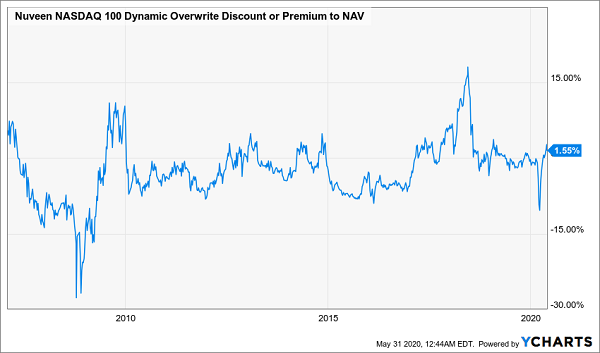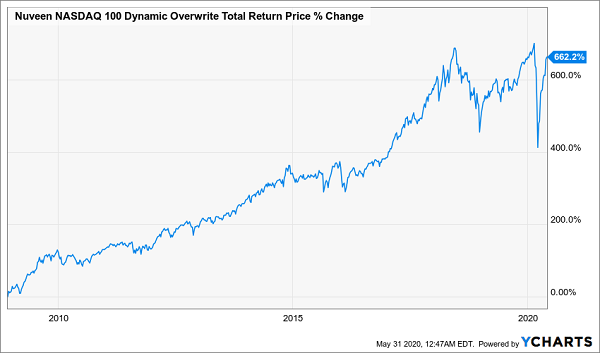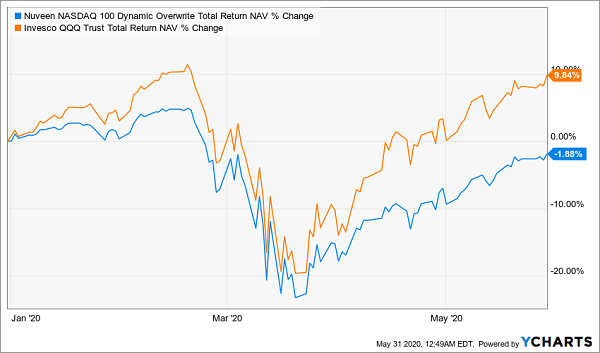If you invest in closed-end funds (CEFs) or are thinking about it (and you should be!), I’ve got great news: there’s one simple indicator that tells you exactly when to buy (or sell) these high-yield income plays.
(If you’re a member of my CEF Insider service, you probably know what I’m going to say next.)
I’m talking about the discount to net asset value (NAV), which you can find on pretty well any fund screener. Today we’re going to see how one group of investors rode this simple metric to an amazing 662% in gains and dividends.
Your 1-Click CEF “Buy Alarm”
The discount to NAV is unique to CEFs. It works like this: due to a quirk in the CEF structure, these funds’ market prices can vary widely from their NAV, or what their underlying portfolios are worth. As a result, you can grab serious upside by making your move when the discount gets unusually wide.
The Nuveen NASDAQ 100 Dynamic Overwrite Fund (QQQX) shows this in action. The fund pays a 6.5% dividend and holds dominant tech stocks like Apple (AAPL), Microsoft (MSFT), Facebook (FB) and Alphabet (GOOGL) among its top-10 holdings:
Overpriced to Oversold … and Back Again

As you can see above, QQQX has gone from a near-30% discount to a 15%+ premium in the last decade. And timing your buys according to these swings would’ve made a huge difference in your return.
For example, take a look at what happened for investors who bought in December 2008, when the fund was trading at an outsized 20% discount to NAV, and held to today:
Big Discount Delivers a 662% Return

That 662% return is incredible, and much more than you would have gotten from a buy just six months later, when QQQX traded at a 10% premium:
Buy at a Premium, Say Goodbye to Half Your Gains

As you can see, by purchasing just six months later, investors who got QQQX when it traded at a premium saw their returns cut in half! That’s how powerful CEF discounts can be.
That’s not the only problem with QQQX right now, though.
At a 2.4% premium to NAV, the fund isn’t as overbought as it’s been in the past. But what’s more worrying is that its underlying portfolio isn’t doing what it’s supposed to.
NAV Slips in a Volatile Market

While the NASDAQ-benchmark Invesco 100 Trust (QQQ) is up nearly 10% in 2020, QQQX is down 1.9% on a total-NAV-return basis (including dividends on the portfolio). That’s despite the fact that both funds invest in the same stocks.
Premium Is Only One Drag on Returns
Why the discrepancy? Because of how QQQX works, and what that means in this market.
QQQX is a covered-call fund, which means it sells call options against its portfolio for cash, then passes that cash on to investors (that’s why its 6.5% yield is much bigger than QQQ’s 0.7%).
Those call options are contracts QQQX sells to investors, giving them the option to buy one of the fund’s holdings at a fixed price at or before a fixed period in the future. If the price of the stock stays below that fixed price, QQQX’s option-writing is highly profitable. But if the stock goes above that fixed price, QQQX’s profits from selling those stocks will fall beneath what it would’ve gotten if it had never sold those options at all.
In a market like we’ve seen recently, where stocks dipped and quickly recovered, writing call options gets tricky. That’s especially true if the fund, like QQQX, writes options on most or all of its portfolio and is required to sell call options by its mandate—two weaknesses that, by the way, do not apply to the covered-call funds in our CEF Insider portfolio.
The bottom line? QQQX is a great fund with great management and a strong portfolio, but its strict option-selling requirements mean it’s not the best fund to buy now. It should trade at a discount to reflect that, and until it does, this 6.5% dividend payer is best avoided.
4 MUCH Better Buys Than QQQX (Average Yield: 9.4%!)
If you’re interested in CEFs, I have more great news for you: your timing couldn’t be better!
That’s because I’ve recently released my 4 very best buys in the CEF universe. These 4 income titans throw off sparkling 9.4% average payouts! PLUS they trade at huge discounts to the value of their portfolios.
Just how cheap are these 4 incredible income plays?
Their discounts are wide enough to ignite 20%+ gains in the next 12 months, even if the market only moves slightly higher from here. And if we do get another downturn, these big discounts give us critical downside protection, helping keep our 4 funds’ market prices stable—while we enjoy their massive 9.4% dividends!
These 4 funds, with their high, safe income streams, are the answer in a crisis like this, and I can’t wait to show them to you. Everything you need to know is waiting for you here: names, tickers, buy-under prices, complete dividend histories—the works!
